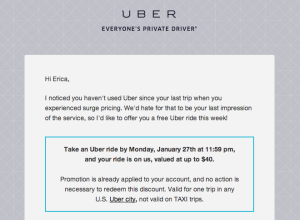Mitigating churn is crucial to the health of your business. Scoring a new customer costs five times as much as marketing that wins you a repeat purchase. That’s a big cost difference, but easy to understand:
- If someone has already purchased from you, you already know they like what you’re selling.
- You have the ability to customize marketing communications based on what you know about them.
- You have a direct line to their inbox — no need to pay Google to get in front of them.
You can’t afford to lose repeat business: best-in-class ecommerce companies get 76% of their revenue from it! With data on your side, there’s no reason you can’t be best-in-class at holding on to your customers.
Calculating churn for your business
The first thing you need to know to start reactivating churned customers is what churn is for your business. While the basic formula for churn is always the same: Churn rate = # of customers lost in a period / # of customers at the beginning of the period, how you define those periods depends on your business.

For example, a SaaS businesses will measure churn very differently than an ecommerce store who designs Christmas outfits for dogs. You need to measure churn in a way that helps you accurately bucket first time purchasers, repeat buyers, and churned customers.
To learn more about how to accurately measure and track churn, check out the microsite we made.
Choose your reactivation strategy
Offer emails
The classic reactivation strategy is a series of increasingly enticing offers — 20% off! 30% off! 50% off! This does work – that’s why it is one of the most-often used methods for customer engagement and reactivation. Scan through your own inbox and you’ll see this is true. But as customers are bombarded by daily discount messages, they lose interest. It’s a noisy space, and it can be difficult to tell what’s actually a click-worthy deal.
Keep in mind, this method also invites margin leak as some customers will come back for the big sale, and then churn again. Data expert, Kevin Hillstrom, is a huge advocate for product, rather than discount-driven emails. The click-through-rate on offer emails gets marketers hooked on a false high. Sure, customers are clicking, but discount hunters won’t necessarily convert at full price.
Invite opt-out and preference resets
Some companies have started sending email messages to churned customers saying something like “Time is running out to keep receiving these great deals!” These messages let a customer know they’re going to be deleted from the marketing list unless they take action. This approach can seem surprising, but trimming genuinely churned customers from your regular lists not only improves your click-through-rates, it also weeds out churned customers in need of a different approach.
We’re all experiencing some form of email fatigue as our inboxes are flooded every day with marketing messages. There’s a likely segment of customers who still want to hear from you — but on their terms. Invite them to reset their preferences on how often they’re contacted. Though you’ll have fewer touchpoints, but those touchpoints will be tailor-made for effectiveness!
Lifecycle oriented-messages

Even for churned customers, there are distinct moments when your content can, once again, become clickable. Remember, you have their purchase history. Email them about them about a new product that’s similar to the one they previously purchased. Even better, tie this to an occasion in their personal life. We almost universally like things that feel like presents. Go ahead and send personalized birthday and anniversary offer messages that make your customers feel special.
Responding to an issue
If a previously loyal customer drops off after they experienced an issue — don’t let them off too easy! Customers who feel actively respected and valued — or that their conflict has been resolved can become your most passionate fans. Don’t be afraid to apologize when something has misfired. Be sincere, and invite your customer to come back and experience the resolution.
Example: Uber surge pricing

Over the winter, Uber got some negative press over their surge pricing (as demand increased due to bad weather, pricing increased). They segmented customers who stopped using the service after experiencing the surge and invited them to come back with a free ride. It changed brand perception and made Uber seem friendly rather than opportunistic.
Increase personalization
For clients with a high customer lifetime value, you can experiment with an actual human approach. Call your customers and talk to them. Even the supposedly phone-phobic millenial generation appreciates the kind of personal service that you can’t get through automation alone. Although don’t think you can’t automate some of it: check out Odesk and Maillift for some clever solutions.
Create educational content
Your customers may have churned because they didn’t understand the full benefits of your product. In that case, creating educational content can give you a huge boost. In October 2013 ViralSweep published the Advanced Guide to Sweepstakes. Giancarlo Massaro, founder of ViralSweep, shared this about what they learned:
“This has not only been the #1 driver in new signups, but also the #1 driver in bringing customers back. We find that a lot of people tried running a giveaway and struck out on their first try (didn’t get many entries or didn’t meet the goals they were trying to reach). This guide walks you step-by-step through setting up, running, marketing, and making sales from giveaways. Many customers came back to us after we published it and said that this resource helped them improve their campaigns, and they originally left us because they didn’t know exactly how to run a successful giveaway. Key takeaway: educating your customers is a great way to reduce churn.”
Micro-conversion
Another approach is to give churned customers a way to engage with you beyond opening their wallets.
Example: ModCloth “Be the Buyer”
ModCloth built a successful “Be the Buyer” program. They invite their community to act as virtual fashion merchants by looking at samples of clothing and voting on which should make it into production. They increase engagement, get feedback on what’s working, how to improve or perk up products, and the winning pieces are the most purchased in their inventory. Customers love the program because they get a voice and play a big role in what they’re sold.
Retarget through other channels
Retargeting is typically used as an acquisition method — but it also works for reactivating customers who’ve simply forgotten about you. It probably won’t work for customers who’ve quit on purpose, cancelling their software subscription or decided that your product doesn’t fit their needs. But — if you sold a pair of snow boots to a customer, they could be very open to coming back to you for their summer sandals.
A targeted banner ad can spark positive memories and prompt a conversion — and you already have the data to optimize this experience between the past purchase and cookie information.
Come back. We’ve changed.
This one is tough. You may have found you were losing certain segments of your users because your product couldn’t match their needs. But now, through sweat and coffee, you’ve evolved and think you deserve your churned customers back.
Even Ebay needed to find a solution for this issue. Earlier in their history, they didn’t have the tools that powerhouse sellers wanted. They didn’t want to lose their most enthusiastic auctioneers. They built out the PowerSeller program, which is now monumentally popular.
Measure your success
As you try these different techniques, remember: always be testing. Segment your customers and try multiple methods to see which are effective. Then, institutionalize the effective strategies.
The metric you want to track is win back rate, which is a measure of customers who came back and remained customers. If this number is too low, it can indicate a problem with your underlying strategy. And you want to make sure the returning customers are sticking with you, not just coming back for a one-time discount grab.
Understanding why customers come back and make repeat purchases will help you design an evolving reactivation strategy with the right balance of messaging and offers to create ever more repeat customers. Don’t let your customers slip away; you know what they want. Go earn them back.


